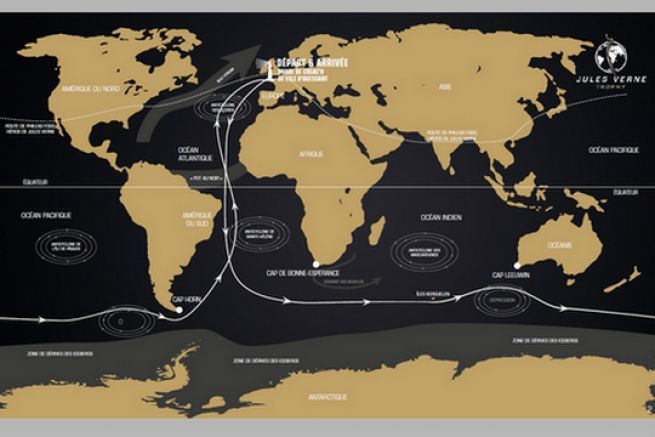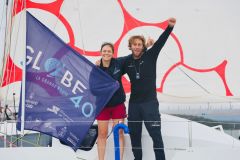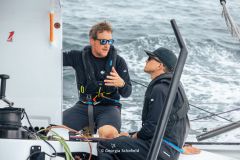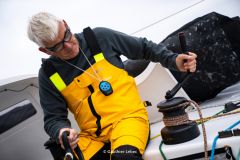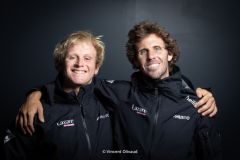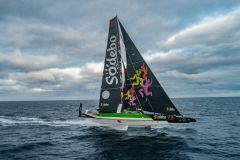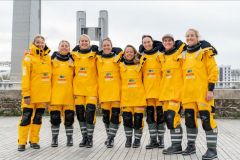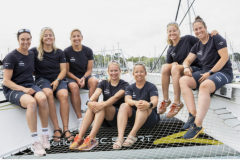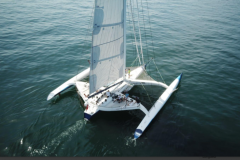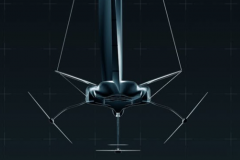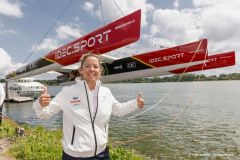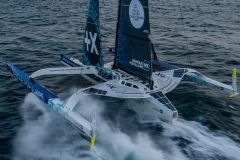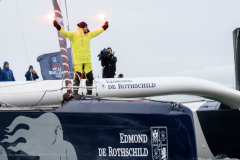How was the Jules Verne Trophy born?
The Jules Verne Trophy is inspired by Jules Verne's novel Around the World in 80 Days. It was the navigator Yves Le Cornec who came up with the idea in 1984, when he embarked on William Saurin, alongside Eugène Riguidel, for the first Québec-Saint Malo transat. The sailor's ambition at the time was to sail around the world in less than 80 days, like the heroes of the novel, Phileas Fogg and Jean Passepartout.
The circumference of the earth at the equator is 21,600 miles (40,000 km). With an average speed of 13 knots, it is therefore possible to complete this circumnavigation of the world in time. However, at that point, the project did not get off the ground.
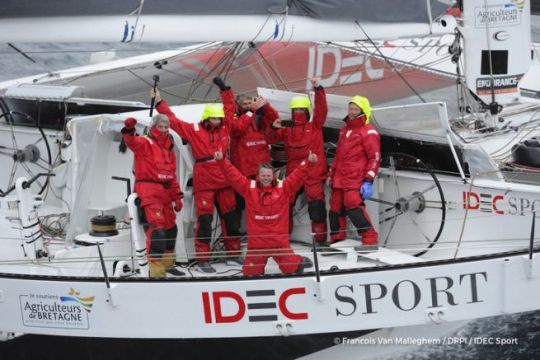
Later, in 1990, Titouan Lamazou, who had just won the Vendée Globe in 109 days 08 hours and 49 minutes, decided to look into the matter. He was accompanied by Florence Arthaud, Sir Peter Blake and Sir Robin Knox-Johnston.
The regulations were created on 13th August 1990, which stipulated that the start and finish would be judged between the Créac'h Ouessant lighthouse and Cape Lizard (English Cornwall), leaving the three capes to port (Good Hope, Leeuwin, Horn).
In October 1992, the Jules Verne Trophy was officially presented by the association "Tour du Monde en 80 jours" chaired by Olivier de Kersauson, in the salons of the Yacht Club de France, under the chairmanship of Jack Lang, Minister of State.
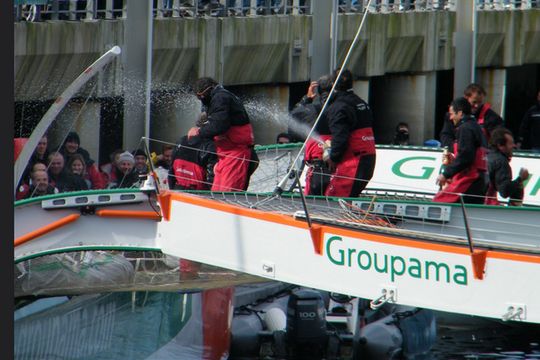
The rules of the Jules Verne Trophy
Preamble
The "Jules Verne Trophy" is unique and will reward the challenger who has improved the round the world sailing record. He will be the depositary of the Trophy and will keep it until his record is improved. The Trophy in this case will be passed on to the new record holder.
Parcours
Cross the starting line defined by an imaginary line, connecting the Créac'h lighthouse on the island of Ouessant and the Cap Lizard lighthouse. Sail around the world, leaving the Cape of Good Hope, Cape Leeuwin and Cape Horn to port. Cross the line defined above in the opposite direction.
Date and continuity
The start line is declared open on the date of official approval of the regulations by the IYRU/WSSRC on 21 April 1997.
Participants
Vessels will be propelled solely by the force of the wind and the crew, and any kind of non-propulsive energy will be allowed (Annex I). The Trophy is open to any type of boat without restriction.
The number of crew members on board is free.
Support
No outside assistance is permitted.
Security
Each challenger boat must respect the safety rules.
Responsibility
The skipper and his crew participate in the trophy at their own risk. The boats must be of a design and construction that ensures total autonomy at sea. Rescue and assistance at sea are governed by the international conventions in force.
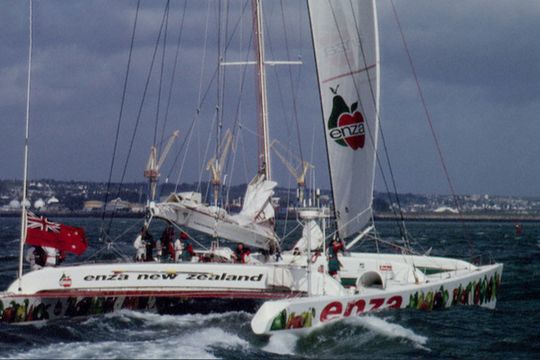
The Jules Verne Trophy prize list
2017 - Francis Joyon - 6 sailors - Idec Sport - Trimaran - 26.9 knots - 40 days 23 hours 30 minutes and 30 seconds
2012 - Loïck Peyron - 14 yachtsmen - Maxi Banque Populaire V - Trimaran - 19,75 knots - 45 days, 13 hours, 42 minutes and 53 seconds
2010 - Franck Cammas - 10 sailors - Groupama 3 - Trimaran - 18.76 knots - 48 days, 7 hours, 44 minutes and 52 seconds
2005 - Bruno Peyron - 14 sailors - Orange II - Catamaran - 17.89 knots - 50 days, 16 hours, 20 minutes and 4 seconds
2004 - Olivier de Kersauson - 11 sailors - Geronimo - Trimaran - 15.72 knots - 63 days 13 h 59 min and 46 seconds
2002 - Bruno Peyron - 13 sailors - Orange - Catamaran - 15.54 knots - 64 days 8 h 37 min and 24 seconds
1997 - Olivier de Kersauson - 7 sailors - Sport-Elec - Trimaran - 13.97 knots - 71 days 14 h 22 min and 08 seconds
1994 - Peter Blake Robin Knox-Johnston - 8 sailors - Enza New Zealand - Catamaran - 13.35 knots - 74 days 22 h 17 min and 22 seconds
1993 - Bruno Peyron - 5 sailors - Commodore Explorer - Catamaran - 12.62 knots - 79 days 6 h 15 min and 56 seconds
A total of 25 starts took place to attempt the Jules Verne Trophy, but only 9 records were set. While in 1993, Bruno Peyron set out to challenge for the first Jules Verne Trophy, it took him 79 days. In 2017, Francis Joyon will only take 40 days, 39 days less, 24 years later.
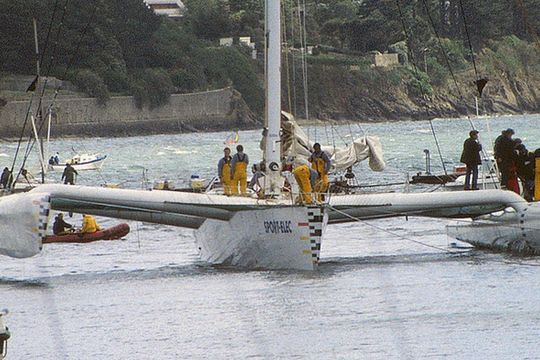
Jules Verne and Around the World in 80 Days
Jules Verne was born in 1828 in Nantes and developed a passion for the sea and travel. Son of a ship owner, he projects himself into adventure through his novels. In 1863, he wrote Five Weeks in a Balloon ...the first of 62 novels in the famous "Extraordinary Journeys" series
In the Round the World Tour in 80 Days, the hero, Phileas Fogg is an English gentleman who makes the crazy bet to go around the globe in less than 80 days. He set off from London on October 2, 1872, crossing the Suez Canal and passing through Bombay, Calcutta, Hong Kong, Yokohama, San Francisco and New York. He took the train and the steamboat, symbols of speed and modernity in the 19th century. At the end of his journey, he returned to London convinced that he had lost his one-day bet. His travelling companion, Passepartout, made him realize that by heading east, he had accumulated jetlag, won 24 hours on the sun and won his incredible challenge.
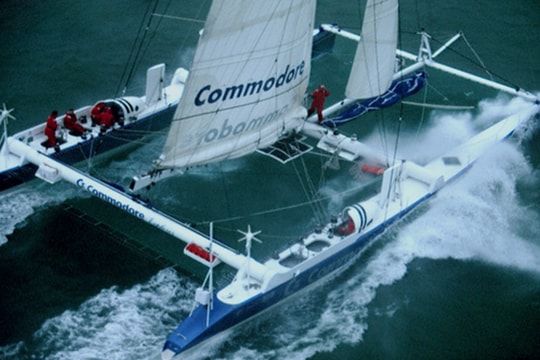

 /
/ 